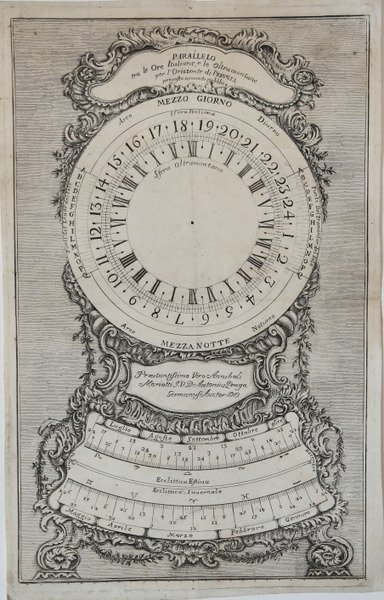Acquaforte e bulino, circa 1780-90 (?), firmata e dedicata in basso al centro: Praesstantissimo Viro Annibali Mariotti J. V. D. Antonius Praga Germanus Auctor DD. Stampata su carta vergata coeva con filigrana del giglio, con margini, in ottimo stato di conservazione. Rappresentazione di un orologio solare, con il confronto tra l’ora italica e l’ora francese al meridiano di Perugia. ' Non abbiamo trovato notizie su Antonio Praga “Germanus”, mentre Annibale Mariotti (1738-1801) fu un medico e letterato perugino di idee liberali, arrestato per non aver ritrattato il proprio sostegno ai francesi, giunti in città nel 1797. L'ora italica, anche detta ora boema, è un metodo di suddivisione del giorno diffusosi a partire dal XIV secolo principalmente in Italia (ma anche in Boemia, Slesia e Polonia), metodo secondo il quale la giornata era divisa in 24 ore della stessa durata, che venivano numerate a partire da mezz'ora dopo il tramonto (quando le campane suonavano l'Ave Maria). Questo momento rappresentava quindi la ventiquattresima ora. ' Il vantaggio principale di questo metodo è che rendeva facile calcolare le ore di luce residue, dato che bastava sottrarre da 24 l'ora tipicamente segnalata dal numero di rintocchi del più vicino campanile. L'inconveniente fondamentale di tale sistema era invece che, dato che l'ora del tramonto cambia durante l'anno, lo stesso momento della giornata era individuato con ore diverse al variare delle stagioni: ad esempio, il mezzogiorno (il momento che divide a metà l'intervallo di tempo tra alba e tramonto) corrispondeva all'incirca con le ore diciannove in inverno e con le ore sedici in estate. Inoltre, la lunghezza delle ore non era costante, variando la distanza di due tramonti successivi di alcuni minuti ogni giorno, in più o in meno a seconda del periodo dell'anno. Tale metodo di calcolo del tempo venne gradualmente soppiantato dopo la metà del XVIII secolo dalla cosiddetta ora alla francese o ultramontana, usata ancor oggi, che definisce le ore dodici (mezzogiorno) il momento della giornata in cui il sole è alla massima altezza. L'adozione di tale metodo fu favorita dalla diffusione degli orologi meccanici, i quali per essere regolati sull'ora italica richiedevano aggiustamenti continui che, vista la rudimentale tecnica del tempo, provocavano problemi di manutenzione dei meccanismi. Il passaggio fu poi definitivamente sancito con il dominio napoleonico sulla penisola italiana. In base a queste informazioni abbiamo datato questo rarissimo foglio alla fine del XVIII secolo. Etching and engraving, circa 1780-90 (?), signed and dedicated at bottom center: Praesstantissimo Viro Annibali Mariotti J. V. D. Antonius Praga Germanus Auctor DD. Printed on contemporary laid paper with “lily” watermark, with margins, in excellent condition. Representation of a solar watch, with the comparison between the Italian time and the French time at the meridian of Perugia. ' We have not found any notice about Antonio Praga "Germanus", while Annibale Mariotti (1738-1801) was a doctor and man of letters of liberal ideas from Perugia, arrested for not having retracted his support to the French, arrived in the city in 1797. The Italic hour, also called Bohemian hour, is a method of subdivision of the day spread from the 14th century mainly in Italy (but also in Bohemia, Silesia and Poland), a method according to which the day was divided into 24 hours of the same duration, which were numbered from half an hour after sunset (when the bells rang the Ave Maria). This moment thus represented the twenty-fourth hour. ' The main advantage of this method was that it made it easy to calculate the remaining hours of light, since it was sufficient to subtract from 24 the hour typically indicated by the number of chimes of the nearest bell tower. The main drawback of this system was instead that, since the time of sunset changes during the year, the same time of day was identified with different hours to vary the seasons: for example, noon (the time that divides in half the time interval between sunrise and sunset) corresponded approximately with the nineteenth hour in winter and with the sixteenth hour in summer. Moreover, the length of the hours was not constant, varying the distance of two successive sunsets by a few minutes each day, more or less depending on the time of year. This method of calculating time was gradually supplanted after the middle of the eighteenth century by the so-called French or ultramontane hour, still used today, which defines the twelve o'clock (noon) the moment of the day when the sun is at its highest point. The adoption of this method was favored by the spread of mechanical clocks, which to be adjusted on the Italian time required continuous adjustments that, given the rudimentary technique of the time, caused problems of maintenance of the mechanisms. The transition was then definitively sanctioned with the Napoleonic domination of the Italian peninsula. On the basis of this information we have dated this rare sheet to the end of the eighteenth century. Cfr.


Find out how to use
Find out how to use

